Print in Andheri continues to accelerate
Andheri in Mumbai is a digital printing powerhouse. The print firms in this busy suburb of Mumbai have a unique approach to print. Prabhat Prakash and Sai Deepthi report
22 Aug 2025 | By PrintWeek India
The Mahakali caves in Andheri were built between the 1st century BC and 6th century AD. 2,000 years later, the district was a hub for manufacturing and workshops in Aamchi Mumbai. And now, in the 21st century, Andheri has transformed into a corporate corner for multiple corporations (including our very own PrintWeek).
Mumbai has been mythologised by many writers. Today, the city has been remade. Walk round Andheri station and you realise digital printshops are part of the identity. These firms (350-sq/ft to slightly larger ops) aren’t just handling basic print jobs and provide a one-stop solution for all-print requirements. In true Mumbai-style, you name the job, and it will be done.
C Sukumaran, senior director, product and communication centre, Canon India, explains that the Andheri market is a hub for digital printing primarily because of the development of industrial areas during post-independence and the concentration of corporate offices that have shifted from South Mumbai to Andheri. “It is centrally located in Mumbai and logistically approachable.”
For a newcomer to Mumbai’s bustling suburbs, the area around Andheri railway station presents a chaotic urban mosaic. Yet, amidst the rush of commuters and a dense landscape of businesses, one thing is conspicuously consistent: the bold, yellow signboards of digital printers that populate the streets. With at least 15 such establishments packed into a two-kilometre radius, this concentration of print power may seem unusual.
But for industry veterans, it tells a story of an industrial hub that has not just survived, but thrived, by adapting to its changing surroundings. “Convenience and comfort are growth engines for short-run digital printing. Andheri offers great connectivity and allows print providers to flourish; it’s right to say that Andheri, as a location, acts as a catalyst,” says Prem Prajapati, regional sales general manager, Konica Minolta. Prajapati mentions that gone are the days when the print providers offered only print, but now it’s way beyond. They have begun offering complete, ready-to-deliver jobs that have thrived in digital printing. Prajapati adds, “The location provides convenience to end customers reach and turnaround jobs in the shortest time. Location has catapulted the growth, and technological upgrades have evolved customer demand.”
Allwyn Jumbo Xerox
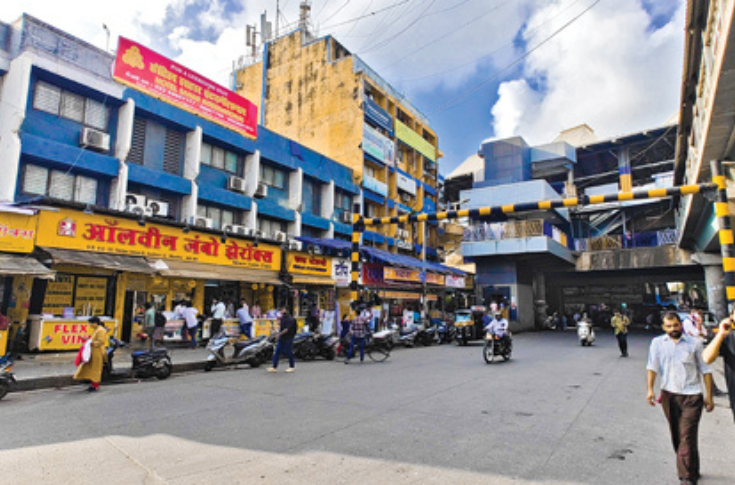
Set up in 1984, Allwyn Jumbo Xerox is a long-standing printing business in Andheri that was born out of necessity, at a time when people had to travel to Kandivali for photocopies, printing floor plans, and blueprints. In the early 1990s, Andheri housed many industrial estates and was in the process of witnessing a transformation and rapid urbanisation; this created a demand for affordable printing solutions as opposed to being a commercial printer with a fleet of offset presses being considered an additional cost.
With no supply in sight despite heavy demand, Allwyn proprietor Kirti Karia’s father launched a print shop that soon became a local essential. Over the decades, the area around Andheri transformed from what was once described as a jungle into a commercial hub, and the shop evolved with it. From traditional paper copies to large-format and digital printing, the company now handles everything from commercial prints to UV and solvent-based jobs.
With 45 employees and a two-lakh monthly print volume, they rely heavily on Xerox machines. Kirti Karia attributes this relationship to the familiarity with the owner, who was a 50-60 machines Modi Xerox machine, and the owner personally knew them since 1984, as the shop was placed right around the corner. The shop also has a mix of Ricoh, Epson, and HP to meet the demand for various uses. “But more than 70% of our demand is met by Xerox, which has CMYK plus two units,” says Karia. The name Modi Xerox itself brings back print nostalgia, as the machines now known as Xerox began as a joint venture between ModiCorp and Rank Xerox in India for several years. The shop is now growing to meet the demand for large-format printing as well. For lamination and post-press jobs, the printer uses Heidelberg, Duplo, and Bindwel. Overrun by its capacity, Allwyn has expanded its space to two other shopfloors.
The shop now serves a mix of everyday consumers and corporate clients, adapting to shifts in demand and sustainability expectations. Despite rising digitalisation, the business sees enduring potential in commercial and visual printing. Karia chuckles while saying, “Even if they want a single copy of the wedding invite to place it near the god, they’d have to print it, and in such cases, only digital print shops come to their rescue.” He is certain that digital printing will not lose its market, as gravure and offset cannot meet the demand for short-run prints. Allwyn also offers UV printing and smart printing with QR codes.
Pacific Digital

Pacific Digital’s story begins in 1992, when it launched as a pre-press unit offering services like high-pass positives, bromides, and newspaper press material. “At the time, everything was film-based,” recalls the second-generation owner Bipin Gala. “We printed positives, bromides, and page layouts manually. That was the essence of pre-press back then.” The shift to digital began around 2000 when the current generation stepped in, learning the ropes on Macintosh systems. By 2006, Pacific Digital had transitioned into flex and large-format printing, adopting digital machines and steadily expanding its infrastructure. Now they manage INR 100-crore of annual turnover with their biggest campaign printing three-lakh sq ft of flex printing in a day.
Originally based in Fort, the company moved to Andheri in 2013 to be closer to Mumbai’s advertising and production ecosystem. Gala says, “We realised that whether it’s a brand activation or a product launch, all roads in digital print eventually lead to a serious print partner, and Andheri is the nucleus.” Over the years, Pacific Digital has weathered industry shifts, particularly the drastic fall in job values, by staying agile, upgrading print technology like heads and RIP systems, and keeping development at the centre of its strategy. The team believes India’s digital print market is still full of potential, especially for those who prioritise quality and rapid turnaround. Keeping up with the times, his most recent purchase is a hand top UV with an AI camera.
Reliance Graphics
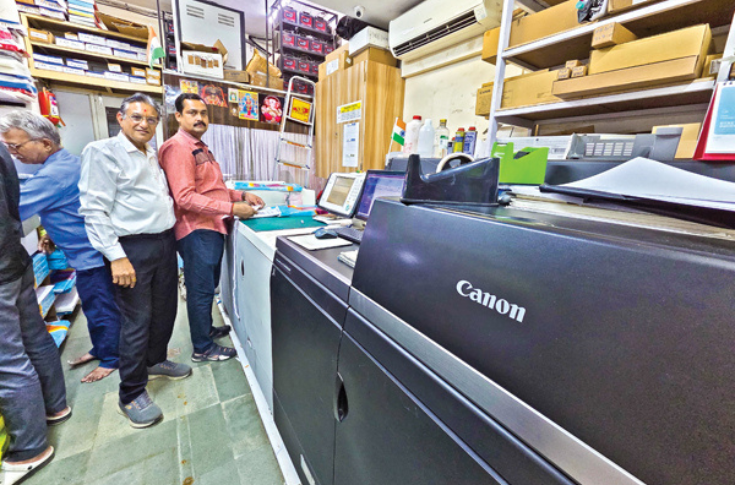
Reliance Graphics has been a quiet force in Mumbai’s dynamic digital printing industry, a journey that began in 1984 with a single outlet in the vicinity of Chhatrapati Shivaji Maharaj Terminus (CSMT). Today, its operations span across two locations, with a presence in Andheri established seven years ago.
“I started at CSMT with one shop. After that, I opened two more branches in CSMT. In total, I opened four branches in CSMT,” says Pravin Shah of Reliance Graphics.
The print landscape of the mid-to-late 1980s was vastly different. Reliance Graphics’ early foray into printing involved a slow, manual Rank Xerox machine. “It was a manual machine,” Shah explains, painting a picture of a bygone era. The evolution of technology steadily brought new opportunities, with the advent of the liquid-based Nashua machine, followed by Canon, and eventually the Modi Xerox machine.
The pivotal moment arrived in 2003, when Reliance Graphics embraced proper digital printing with the installation of a Canon CLC 1000 press. “I got a digital press in 2003, two machines at a CSMT branch,” Shah clarifies. This was followed by a Xerox 125 Safida and a Xerox DC12.
Further expansion in 2005 saw the addition of an Xerox 3535. By 2010, the third and fourth digital presses were installed, including a Mimaki flex machine and an Epson 1253. The commitment to staying ahead continued, with another Canon 10,000 installed in 2018, accompanied by a new plotter. Today, the operation encompasses three machines in CSMT and two in Andheri East.
Reliance Graphics currently employs 60 people across its branches, leveraging a diverse fleet of machines. The capabilities include both toner-jet and liquid-ink technologies. The owner noted that both are utilised extensively. The liquid-ink segment features a Riso machine, with a speed of 145 copies per minute, while their toner-based machines achieve 100 copies per minute, including the Canon V1000. The maximum print resolution reaches 1800x1800 dpi on Canon machines and 1200x1200 dpi on their Epson inkjet plotter and Riso machines.
The business prides itself on its comprehensive in-house capabilities. “I have everything in-house. Whatever you say, whatever you want, I have it in-house,” Shah affirmed. The setup includes safe cutting machines, UV direct to film (UVDTF) technology, UV printers, and a full range of binding equipment. Crucially, the firm also operates an offset machine at its MIDC facility in Andheri East, allowing it to offer complete print solutions. Reliance Graphics supports printing on substrates from 70-gsm to 400-gsm and offers a wide array of products, including rigid boxes, paper bags, pizza boxes, and labels. The software arsenal includes Fiery Command Workstation and Onyx alongside standard design tools like Corel and Adobe Photoshop.
A key specialisation of Reliance Graphics is short-run commercial printing. “I do everything in short runs,” Shah states, highlighting his firm’s agility. This includes variable data printing (VDP), for which dedicated software is utilised, regularly handling 60,000 to 70,000 VDP prints daily, often for numbering applications like ID cards. For packaging, the focus is on boxes, specifically rigid boxes, and wide-format labelling.
The workflow at Reliance Graphics is customer-centric. With eight in-house designers, they can assist clients from the initial design phase. A critical step involves material availability and costing. Shah explained, underscoring his commitment to transparency and efficiency. The firm also provides expert guidance on material thickness and type, even offering samples for large-quantity jobs. The pre-press setup handles basic requirements, ensuring files are print-ready.
Colour management is paramount. Daily machine calibration ensures consistency across print runs. Regarding the choice of machinery, Shah’s preference for Canon is clear; he says, “Canon’s features are good. Colours are also good. Its service is much better.” Purchasing decisions are based on extensive self-researched R&D.
The business’s resilience is evident in its handling of maintenance. Regular preventative maintenance, including Fiery updates every morning for colour consistency, keeps downtime to a minimum, typically 15 to 20 minutes every eight days.
For durability, especially for outdoor applications, the firm uses high-quality ink and lamination. On sustainability, while not formally certified, the company actively segregates waste paper, providing white paper for recycling. The firm avoids discarding entire batches by checking proofs diligently and maintaining consistency.
Financially, the owner noted the shift in setup costs from INR 10-lakh for older black and white units to INR three to four-crore for modern digital units. However, the investment is offset by reduced production time and wastage, which has dropped from 20% to just 2% to 3%. The target for return on investment for a new unit is a pragmatic three years.“More than marketing, we focus on quality,” Shah concluded, underscoring the core philosophy that has sustained Reliance Graphics for four decades and continues to bring customers back for its unwavering commitment to excellence in print.
Shraddha Jumbo Xerox
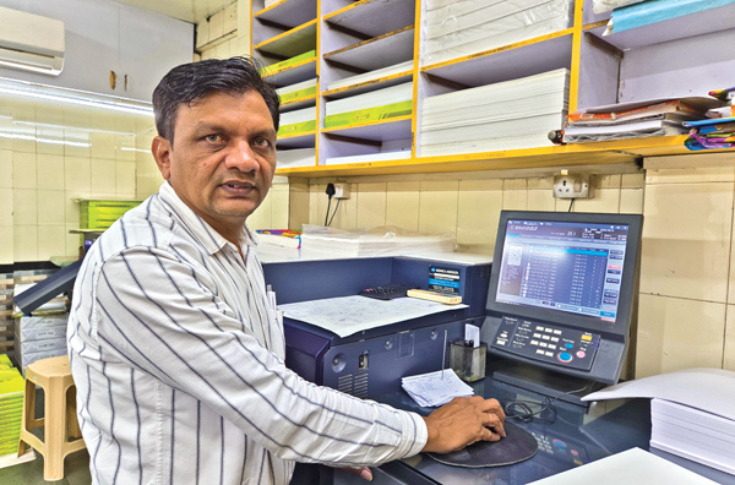
With beginnings in 2007 with a modest photocopying machine, Shraddha Jumbo Xerox has expanded its operations into digital printing. The owner, Kishor Gami, has steered his business from a simple stationery and photocopying outlet into a powerhouse of digital print, a transition that truly took root in 2018.
Mentioning the current location where he runs his operations from, Gami says, “I started the shop here in 2018. It’s been seven-to-eight years since then.” Recounting and clarifying the exact pivot point. Before 2018, Shraddha Jumbo Xerox served as a general retail and stationery shop, offering basic printing and photocopying services. The strategic decision to embrace digital printing in 2018 proved to be a game-changer.
The first major investment in this digital journey was a Konica 6085 digital press, acquired in 2018. The success and growing demand necessitated expansion. Just a year later, in 2019, a second Konica press, the 6100, was added to the fleet. A Ricoh digital press joined the lineup in 2023. Most recently, towards the end of 2024, the company further enhanced its capabilities by installing a Pixel Glow UV Foil machine, stepping into the realm of embellishments. Today, the firm employs a team of 10 to 12 skilled individuals.
All the presses in the facility are toner-based and boast a maximum print resolution of 1200 x 1200-dpi. The equipment allows printing on a range of substrates, from lightweight 45-gsm paper up to sturdy 400-gsm stock. Beyond standard paper, the presses can handle non-tearable materials, textured papers, various stickers, and even metallic papers and stickers, catering to a wide array of client needs. While the maximum sheet size the presses can handle is 13 x 52 inches, the maximum deliverable paper size to clients is typically 13x14 inches.
The operation streamlines its workflow by not maintaining a separate pre-press department or using dedicated RIP software. Instead, the team proficiently utilises industry-standard software such as Adobe Photoshop, Illustrator, and Corel for job setups. Colour management is diligently handled in-house, with machines undergoing daily calibration to ensure minimal colour variation and consistent output quality. The printer’s specialisation lies in high-quality brochures and large-format coffee table books. A strength that sets the firm apart is its ability to apply foil embellishments directly onto textured papers. This offering allows them to cater to premium segments and deliver truly differentiated products.
For job submissions, clients typically provide print-ready files. For larger quantities, samples are always produced for client approval before proceeding with bulk printing. If a client requires pre-press work, the team facilitates this through a trusted collaborative partner.
Efficiency is a cornerstone of their operation. For short-run digital print jobs, such as 250 sheets, the turnaround time is remarkably swift, averaging five to 10 minutes. With two high-speed machines running concurrently, the firm can produce 1,000 copies in 10 minutes. The firm also handles short-run packaging, primarily for sampling purposes.
The company minimises waste by diligently obtaining customer approval on samples before initiating large print runs. Recycled paper is used strictly based on client requests. The digital operation now manages between 300 to 400 jobs daily, encompassing everything from small sticker runs to larger brochure projects. This Mumbai printer’s journey from a small photocopy shop to a digitally-advanced printing facility is a testament to foresight, strategic investment, and a relentless focus on client needs and operational efficiency in India’s dynamic print industry.
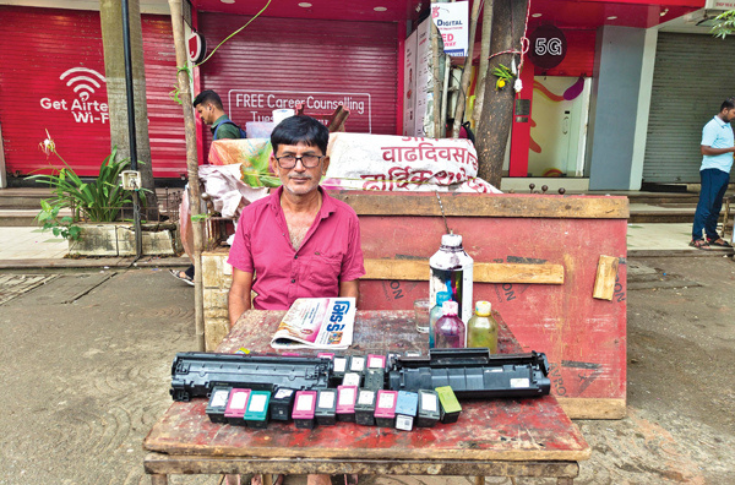
Before you walk over to digital printing adda in Andheri, the Metro exit takes you to Shivaji Makhwana, who has set up a small table for ink cartridge repair opposite the printing shops. Makhwana began operations around 2002 when there was a surge in home computers and printers. Spotting a gap in affordable and accessible repair services, he launched his own business to provide convenient solutions to office and home users.
Most of Makhwana’s clients aren’t big digital shops but everyday users looking for a trustworthy service. During the Covid-19 lockdown, he provided remote service and built a loyal base. He handles repairs for major brands like HP and Canon. He has observed an uptick in HP digital machines, but he maintains that the overall demand for home and commercial printers has gone down. The demand for repair and service is also witnessing a decline, with Chinese goods and alternatives entering the market that are easily replaceable.
Andheri is fascinating. Print servicers like Shivaji Makhwana encapsulate a lot of eccentrics who as he says is “hidden in plain public view” doing interesting, curious things. And at the moment, Andheri is a place where every possible print culture works together into a sort of seething mix which gives it qualities that other places don’t have.








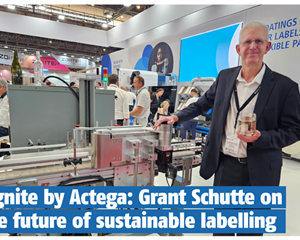
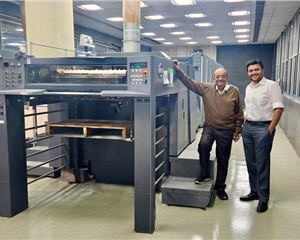
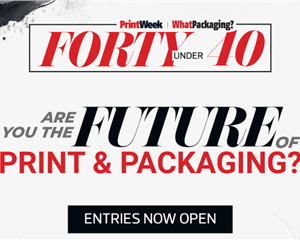
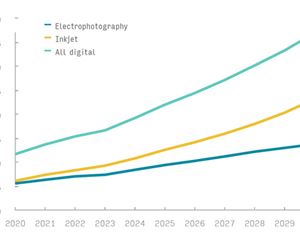
 See All
See All